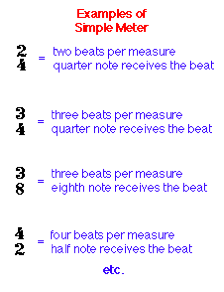 |
|
 |
 |
 |
 | In simple meter, each beat is normally subdivided into two parts, and the note receiving the beat is always a standard single note value (i.e. a quarter, half, eight, etc.) In musical notation, this is indicated by a time signature, which provides information on how many beats are in each grouping, and which note value receives the beat. A time signature is notated by two numbers, one above the other, at the beginning of each piece and whenever there is a change of meter in the work.
In simple meter:
The top number indicates the number of beats per measure.
The bottom number indicates the rhythmic note value that receives the beat.
For example, a meter with 3 beats per measure with the quarter note receiving the beat is called "3 - 4" time, and is notated with a "3" in the top number and a "4" in the lower number.
|
 |
 |
 |
 |
 |
 |
The time signature of "4 - 4" is so commonly used that publishers and composers often abbreviate it with a "C" for common time. A "C" with a slash through it indicates cut time which is equal to "2 - 2"
|
 |
 |
|


 |
 |
 |


